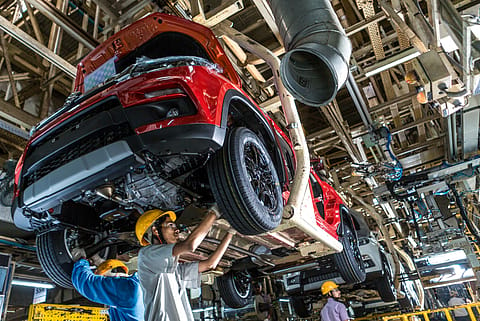Manufacturing PMI slips in November, but export demand fuels growth
India's manufacturing PMI eased to 56.5 in Nov 2024 from 57.5 in Oct, a joint 11-month low but staying in expansion territory; new export orders hit a 4-month high

India recorded a 56.5 manufacturing PMI in November 2024, down slightly from the prior month but still firmly within expansionary territory. Falling from 57.5 in October to a joint 11-month low of 56.5 in November, the seasonally adjusted HSBC India Manufacturing Purchasing Managers’ Index (PMI) signalled a "softer improvement" in the sector's health.
Strong broad-based international demand, evidenced by a four-month high in new export orders, fuelled the Indian manufacturing sector’s continued growth.
The HSBC India Manufacturing PMI showed improvement in the overall health of the sector during the month, despite downward movements in most of its subcomponents.
"Positive demand trends fed through to sharp expansions in sales and output, though firms indicated that growth was somewhat restricted by competitive conditions and prices pressures. The latest results shows that a quicker upturn in cost burdens sparked the steepest rise in selling prices in over 11 years."
The pace of growth remained above its long-run average, shows the survey. "Goods producers experienced a weaker, albeit still robust, upturn in new business intakes during November. The rate of expansion was the second-weakest in 11 months, ahead of that registered in September. Growth was supported by favourable demand conditions, but stymied by fierce competition and price pressures."
The latest results showed that Indian goods producers increased their selling prices to the greatest extent since October 2013. Survey participants suggested that additional outlays on freight, labour and materials had been shared with clients. Input cost inflation intensified midway through the third fiscal quarter, reaching its highest mark since July but remaining below its long-run average. "Chemicals, cotton, leather and rubber were reported as up in price. Although price pressures curbed domestic sales to a certain extent, growth of new export orders gained momentum. The rate of expansion in international demand was the best seen for four months, with panellists reporting gains from Bangladesh, mainland China, Colombia, Iran, Italy, Japan, Nepal, the UK and the US."
Pranjul Bhandari, Chief India Economist at HSBC, says strong broad-based international demand, evidenced by a four-month high in new export orders, fuelled the Indian manufacturing sector’s continued growth. "At the same time, however, the rate of output expansion is decelerating due to intensifying price pressures. Input prices for a variety of intermediate goods — including chemicals, cotton, leather, and rubber — rose in November, while output prices soared to an eleven-year high as rising input, labour, and transportation costs were passed on to consumers."
Recommended Stories
In terms of demand, conditions remain favourable. Indian manufacturers continued to scale up production, says the survey. "The rate of expansion receded to the weakest in the calendar year to-date, though remained historically strong. The slowdown reportedly reflected competitive conditions, inflationary pressures and subdued orders at some units."
For the ninth month in a row, factory employment in India increased during November. "Despite softening from October, the rate of job creation remained solid. According to panel members, staff had been hired on both permanent and temporary bases."
Meanwhile, a sequence of falling stocks of finished goods dating back to August 2017 came to an end, according to the report. "Recent capacity expansion efforts and forecasts of demand strength also underpinned upbeat forecasts for output in 2025."